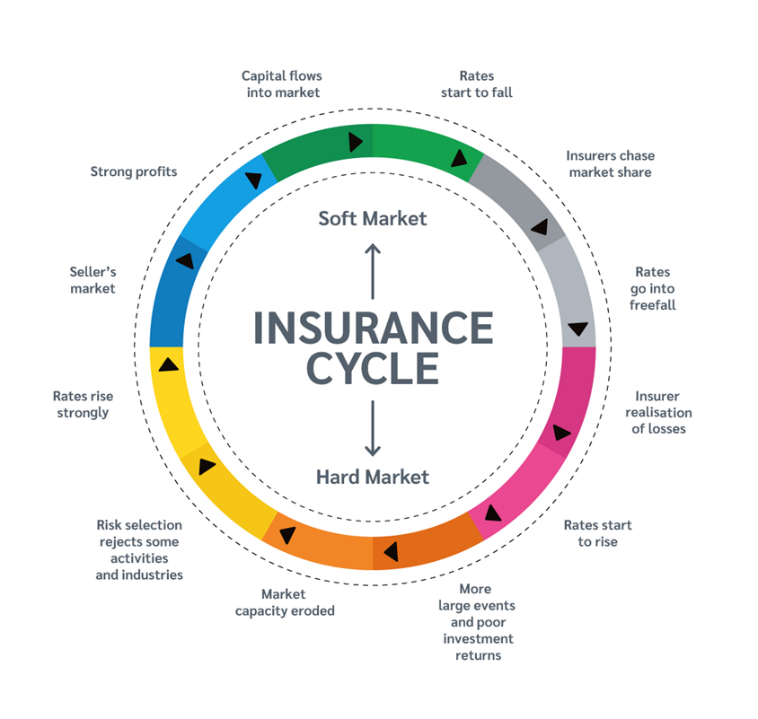The insurance sector is currently experiencing a “hardening” property/casualty market with some observers already calling it a “hard market”. Either way, policy conditions have been deteriorating for insurance buyers for some time, and understanding the dynamics is essential to achieve a good deal at renewal.
Underwriting or insurance cycles usually span over a number of years and describe trends in rates and terms and conditions of property/casualty policy contracts. From an insurance buyer’s perspective, the cycle is characterized by periods of “soft” market conditions, in which premium rates are stable or falling and insurance is readily available, and by periods of “hard” market conditions, where rates rise and the envisaged coverage may be more difficult to find.
The cycle dynamics
In a typical underwriting cycle, market conditions for the underwriting business go from boom to bust and back to boom again. A cycle usually starts with many competitors with plenty of capacity and low premiums. Eventually, a surge in claims drives lesser-capitalized insurers out of business and competition declines. Less competition and insurance capacity improve underwriting conditions for the remaining insurers, enabling higher premium and more stringent underwriting standards. Such an environment usually helps strengthening insurers’ financial results. The prospect of higher profitability attracts fresh capital and new entrants to the market offering lower premium and looser requirements. The increased competition leads to a reduction in premium as incumbents are forced to follow suit and the cycle begins again.

Among the reasons for the existence of underwriting cycles is that a majority of insurers value short-term profits more than long term stability. A contributing driver is the inherent uncertainty of aligning insurance prices with future losses, a task that becomes more difficult the longer the time span between the contract agreement and the potential filing of a claim.
The current insurance climate
While calling the current insurance environment a “hard” market may go too far for some, it is undisputed that the market is “hardening”. Rates are mostly going up at renewal even for claims-free risks. Terms and conditions are also becoming more restrictive. This is prolonging renewal negotiations as insurers are requesting more information. Reaching an acceptable deal for insureds is becoming more complicated.
There are several explanations for the current climate:
As opportunities for acceptable investment returns were scarce in the past years due to a low interest rate environment, investors turned to the insurance industry and increased available underwriting capacity. The competition helped create a soft market.
Low interest rates have been severely undermining profitability of the insurance industry over the past years as they pressured investment returns. The COVID-19 pandemic has impacted an already fragile global economy. A pessimistic outlook for the economy can push interest rates even lower to stimulate the economy.
P&C insurers have therefore been pushing for higher premium to be able to offer the level of protection businesses and individuals are after.
A number of natural and man-made catastrophes have produced large losses, strengthening insurers’ negotiating position.
Non-life commercial insurance providers have reported double-digit price increases for a variety of lines of business across all major global regions for 2019, according to Swiss Re (opens a new window). Among the drivers for price increases are rising claims, with some insurers having raised prices drastically in loss-affected lines. Others decided to withdraw completely from certain lines or geographies, pushing up pricing further in light of reduced underwriting capacity. Swiss Re expects this trend to continue, not least because some insurance lines such as credit and surety as well as liability are likely to experience higher claims this and next year. The reinsurer is expecting “strong” rate increases in credit and surety going forward and moderate rate increases in other affected lines of business and portfolios, including directors and officers (D&O) and medical malpractice.
During a soft market customers are able to negotiate lower insurance prices, as insurers compete for business, sometimes at below cost. When the market hardens, as is currently the case, insurance buyers need to be better prepared for renewal negotiations.
Recommendations:
Prepare well ahead of renewal and remain open to adjusting the strategy according to market responses.
Differentiate the risk and prepare a detailed submission.
Review and adjust the insurance programme structure.
In a hardening market, personal presentations to underwriters can make a real difference.
Communication between all parties should be constant and transparent throughout.
As market capacity retracts, so does the competition, resulting in remaining insurers obtaining their ‘technical’ rates with increased deductibles and narrowing of policy coverage. It is an old adage but clients need to recognise these forces of change and think proactively about how they ‘sell’ their risk to interested insurers.
Important risk management initiatives
Lessons learnt and acted upon – near misses and/or recent claims.
Modelling the impact of a major storm/fire loss – are the limits previously purchased relevant?
Modelling retaining greater share of the risk; “should insure” versus “can insure” versus “should retain” is a timely reminder of insurance buying strategies based on the insured’s risk appetite.
Get to know your insurers and identify why the market should be allocating their risk financing capital to your risk – no one will ‘sell’ risk better than the insured.
Ensure there is a clear and detailed broking strategy discussed and agreed with the broker; who, where, when, what and how has never been more relevant.
Manage internal expectations: There have been many years of delivering insurance expenditure savings year on year. Now the board needs to comprehend the winds of change are likely to deliver rate increases.
It would be fair to say that, even with 3 years of increases and escalating upwards, the 2020 renewal rates will still remain below the rates paid in 2000 post 9/11.
For further information, please contact:
Alex Boswell, Partner Lockton UK
T: +44 (0)20 7933 2897
E: alex.boswell@uk.lockton.com (opens a new window)


